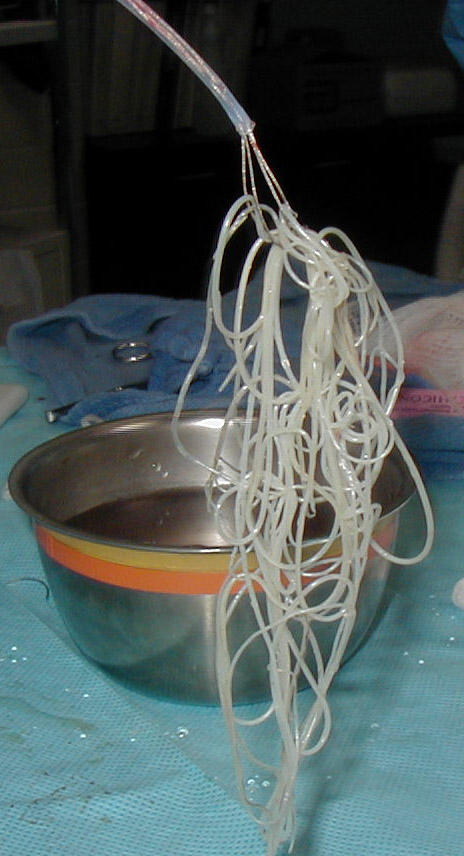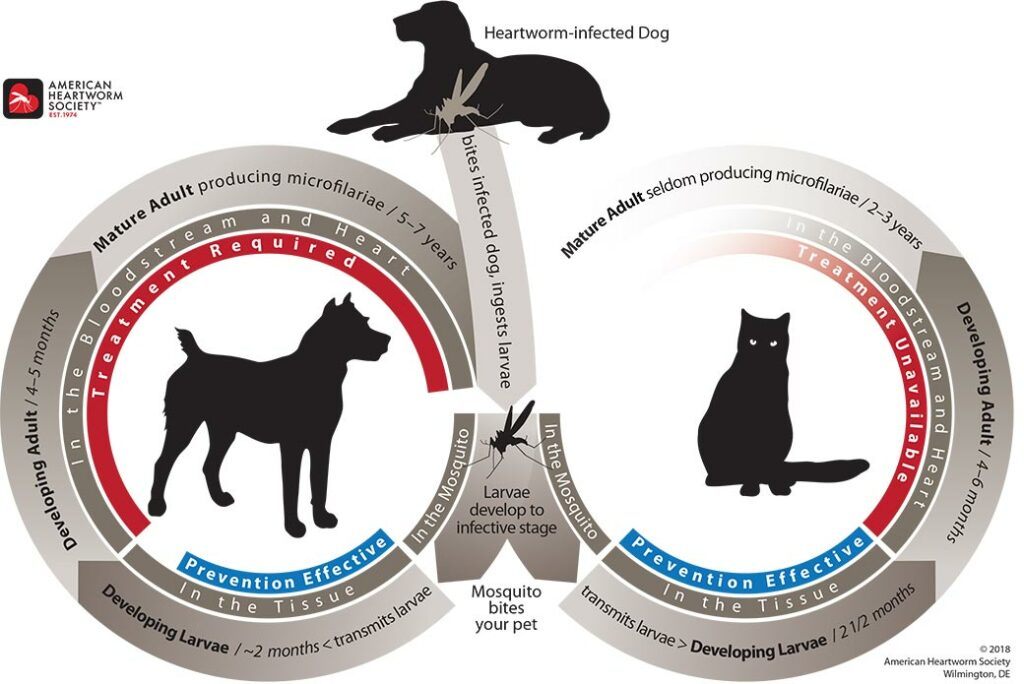What is Heartworms in Dogs?

There are always a lot of questions about Heartworms in dogs. I will do my best to cover the causes of heartworms in dogs, testing, prevention, symptoms and treatment of heartworms in this post. This information will hopefully prepare pet owners in general to be vigilant of their pets surroundings and have a clearer understanding about where the dangers may lie.
So, what is Heartworms in Dogs?

Heartworm is one of the most serious diseases that not only affects dogs but also affects cats and ferrets and sometimes other pets as well. This disease normally will lead to lung disease, heart failure, organ damage and death. Heartworm disease is caused by a parasite worm called Dirofilaria immitis.The worms are spread through the bite of a mosquito. A dog would be the definitive host. What that means is that the worms will grow into adults where they will mate and produce offspring while inside the dog. The mosquito is the intermediate host. This means that the worms have to live inside the mosquito until they become infective and are able to cause heartworm disease. The worms are called “heartworms” because the adults live in the heart, lungs, and associated blood vessels of an infected dog or animal.
The life cycle of the Heartworm.

In an infected dog, adult female heartworms release their offspring, called microfilariae, into the dog’s bloodstream. When a mosquito bites the infected dog, the mosquito becomes infected with the microfilariae. Over the next 10 to 14 days and under the right environmental conditions, the microfilariae become infective larvae while living inside the mosquito. Microfilariae must pass through a mosquito to become infective larvae. When the infected mosquito bites another dog, the mosquito spreads the infective larvae to the dog through the bite wound. In the newly infected dog, it takes about 6 to 7 months for the infective larvae to mature into adult heartworms. The adult heartworms mate and the females release their offspring into the dog’s bloodstream, completing the life cycle.
Heartworm disease is not contagious, meaning that a dog cannot catch the disease from being near an infected dog. Heartworm disease is only spread through the bite of a mosquito.
Inside a dog, a heartworm’s lifespan is 5 to 7 years. Adult heartworms look like strands of cooked spaghetti, with males reaching about 4 to 6 inches in length and females reaching about 10 to 12 inches in length. The number of worms living inside an infected dog is called the worm burden. The average worm burden in dogs is 15 worms, but that number can range from 1 to 250 worms.
How is a Dog Tested for Heartworms?
A veterinarian uses blood tests to check a dog for heartworms. Heartworms have proteins called antigens, which are released into the dogs bloodstream by adult femals. An antigen test will detect if there is a presence of at least 1 adult female heartworm in the system. The earliest that the heartworm proteins can be detected in a dog’s bloodstream is about 5 months after it is bitten by an infected mosquito.
Another test detects microfilariae in a dog’s bloodstream. Microfilariae in the bloodstream indicate that the dog is infected with adult heartworms (because only adult heartworms can mate and produce microfilariae). The earliest that microfilariae can be detected in a dog’s bloodstream is about 6 months after it is bitten by an infected mosquito (because it takes about that long for the heartworms to develop from infective larvae into adults that mate and produce microfilariae).

When Should a Dog Be Tested for Heartworms?

The timing and frequency of heartworm tests depend on many factors. Some of these factors include:
- The dog’s age when heartworm prevention is started;
- If the owner forgot to give heartworm prevention and for how long;
- If the dog is switched from one type of heartworm prevention to another;
- If the dog recently traveled to an area where heartworm disease is more common; and
- The length of the heartworm season in the region where the dog lives.
Dogs that are 7 months of age and older should be tested for heartworms before starting heartworm prevention. A dog may appear healthy on the outside, but on the inside, heartworms may be living and thriving. If a heartworm-positive dog is not tested before starting a preventive, the dog will remain infected with adult heartworms until it gets sick enough to show symptoms. Heartworm preventives do not kill adult heartworms. Also, giving a heartworm preventive to a dog infected with adult heartworms may be harmful or deadly. If microfilariae are in the dog’s bloodstream, the preventive may cause the microfilariae to suddenly die, triggering a shock-like reaction and possibly death.
Annual testing of all dogs on heartworm prevention is recommended. Talk to your dog’s veterinarian about the best time for your dog’s annual heartworm test. Keep track of all your preventatives, care and important dates to remember on a calendar.
What are the Symptoms of Heartworm Disease for Dogs?

The severity of heartworm disease is related to how many worms are living inside the dog (the worm burden), how long the dog has been infected, and how the dog’s body is responding to the presence of the heartworms. The dog’s activity level also plays a role in the severity of the disease and in when symptoms are first seen. Symptoms of heartworm disease may not be obvious in dogs that have low worm burdens, have been recently infected, or are not very active. Dogs that have heavy worm burdens, have been infected for a long time, or are very active often show obvious symptoms of heartworm disease.
There are four classes, or stages, of heartworm disease. The higher the class, the worse the disease and the more obvious the symptoms.
- Class 1: No symptoms or mild symptoms such as an occasional cough.
- Class 2: Mild to moderate symptoms such as an occasional cough and tiredness after moderate activity.
- Class 3: More severe symptoms such as a sickly appearance, a persistent cough, and tiredness after mild activity. Trouble breathing and signs of heart failure are common. For class 2 and 3 heartworm disease, heart and lung changes are usually seen on chest x-rays.
- Class 4: Also called caval syndrome. There is such a heavy worm burden that blood flowing back to the heart is physically blocked by a large mass of worms. Caval syndrome is life-threatening and quick surgical removal of the heartworms is the only treatment option. The surgery is risky, and even with surgery, most dogs with caval syndrome die.
Not all dogs with heartworm disease develop caval syndrome. However, if left untreated, heartworm disease will progress and damage the dog’s heart, lungs, liver, and kidneys, eventually causing death.
Is There a Treatment for Heartworm Disease in Dogs?

The treatment for heartworm disease is not easy on the dog or on the owner’s pocket book. Treatment can be potentially toxic to the dog’s body and can cause serious complications, such as life-threatening blood clots to the dog’s lungs. Treatment is expensive because it requires multiple visits to the veterinarian, blood tests, x-rays, hospitalization, and a series of injections.
The Best Treatment is Prevention!

Many products are FDA-approved to prevent heartworms in dogs. All require a veterinarian’s prescription. Most products are given monthly, either as a topical liquid applied on the skin or as an oral tablet. Both chewable and non-chewable oral tablets are available. One product is injected under the skin every 6 or 12 months, and only a veterinarian can give the injection. Some heartworm preventives contain other ingredients that are effective against certain intestinal worms (such as roundworms and hookworms) and other parasites (such as fleas, ticks, and ear mites).
Year-round prevention is best! Talk to your dog’s veterinarian to decide which preventive is best for your dog.
The main society for prevention of Heartworms advocates to “Think 12.” Give dogs 12 months of heartworm prevention and get them tested for heartworms every 12 months.
Can Cats Get Heartworm Disease?

Cats can also get heartworms after being bitten by an infected mosquito, although they are not as susceptible to infection as dogs. A cat is not a natural host of heartworms because the worms do not thrive as well inside a cat’s body. Both indoor and outdoor cats are at risk for heartworm disease.
Is Heartworm Disease Different in Cats?
Heartworm disease in cats is a bit different than in dogs. Heartworms in cats do not live as long (average lifespan is only 2 to 4 years) or grow as long, and fewer of them mature into adults. Worm burdens are lower in cats than dogs. Usually a cat has only one or two worms. However, due to its relatively small body size, a cat with only a few worms is still considered to be heavily infected.
In cats, it takes 7 to 8 months for infective larvae to mature into adult heartworms and produce microfilariae. This is about one month longer than in dogs. The presence of microfilariae in a cat’s bloodstream is uncommon. Only 20 percent of cats with heartworm disease have microfilariae in the bloodstream, compared to 80 to 90 percent of dogs with heartworm disease. Also, the presence of microfilariae in the bloodstream is inconsistent and short-lived in cats.
It is harder to detect heartworm infections in cats than in dogs. Veterinarians generally use two types of blood tests in combination to check a cat for heartworms. However, negative test results do not rule out heartworm infection, and positive test results may or may not mean that there is an active heartworm infection. A veterinarian uses the results of both blood tests, along with the cat’s symptoms and the results of other tests such as x-rays and an ultrasound of the heart, to determine if a cat has heartworm disease.
What are the Symptoms of Heartworm Disease in Cats?

Not all cats with heartworm disease show symptoms. Some cats are able to spontaneously rid themselves of heartworms without having any symptoms. However, some infected cats die suddenly from heartworm disease without ever showing signs of being sick. Cats with heartworm disease may have very nonspecific symptoms that mimic many other cat diseases. These nonspecific symptoms include vomiting, decreased activity and appetite, and weight loss. Cats with heartworm disease rarely show signs of heart failure.
In cats that show symptoms of heartworm disease, respiratory signs are the most obvious due to the lung damage caused by the heartworms. Cats typically show symptoms of heartworm disease at two time points – when the immature heartworms arrive in the arteries of the heart and lungs and when the adult heartworms die.
The immature heartworms arrive in the heart and lung arteries about 3 to 4 months after a cat is bitten by an infected mosquito. Many of these immature heartworms die, causing a strong inflammatory response in the cat’s lungs. This response is called heartworm associated respiratory disease (HARD) because respiratory signs, such as trouble breathing, increased respiratory rate, and cough, are the most obvious. It may be difficult to distinguish HARD from feline asthma or feline bronchitis.
When the adult heartworms die, they release toxins into the cat’s bloodstream which cause lung damage, leading to respiratory problems or sudden death. Even the death of one worm can be fatal for a cat.
There is no FDA-approved drug to treat heartworm disease in cats, although symptoms may be managed with medications. Surgical removal of adult heartworms may be a treatment option if the heartworms can be seen by ultrasound. But surgery is risky, and if the heartworms are not removed intact, there can be potentially serious complications, such as shock and death.
Again, Prevention is the Best Treatment!
Several products are FDA-approved to prevent heartworms in cats. There are both topical and oral products for cats, and all are given monthly and require a veterinarian’s prescription. Some heartworm preventives contain other ingredients that are effective against certain intestinal worms (such as roundworms and hookworms) and other parasites (such as fleas, ticks, and ear mites).
Again, year-round prevention is best! Talk to your cat’s veterinarian to decide which preventive is best for your cat.
Should Cats Be Tested for Heartworms?
It is recommended that cats be tested for heartworms before starting heartworm prevention, although this pre-testing is less useful than in dogs. Talk to your cat’s veterinarian about testing your cat for heartworms.

Photo courtesy of David A. Crum, DVM, MPH
What about Heartworm Disease in Ferrets?
Ferrets can also get heartworms from the bite of an infected mosquito. Ferrets are similar to dogs in their susceptibility to heartworm infections, but their symptoms are more similar to those seen in cats.
Infected ferrets typically have low worm burdens, and microfilariae are seen in the bloodstream in only 50 to 60 percent of ferrets with heartworm disease. Symptoms of heartworm disease in ferrets include decreased activity level, coughing, trouble breathing, and overall weakness. Heart failure can occur in severe cases. Based on a ferret’s symptoms, a veterinarian may perform chest x-rays and an ultrasound of the heart to determine if it has heartworm disease. Blood tests to detect heartworm infections in ferrets are generally unreliable.
No drugs are FDA-approved to treat heartworm disease in ferrets. And only one drug, Advantage Multi for Cats (imidacloprid and moxidectin), is approved to prevent heartworms in ferrets. Available only with a veterinarian’s prescription, it is a topical solution that is applied monthly. Besides preventing heartworms, Advantage Multi for Cats also treats flea infestations on ferrets by killing adult fleas.
Again, prevention is the best treatment! Year-round prevention is recommended for all ferrets. Talk to your ferret’s veterinarian about preventing heartworm disease in your furry friend.
Can People Get Heartworms from Their Pets?
People cannot get heartworms from their pets. Heartworms are only transmitted by the bite of an infected mosquito. In rare cases, people can get heartworms after being bitten by an infected mosquito. But because people are not a natural host for heartworms, the larvae usually migrate to the arteries of the heart and lungs and die before they become adult worms.

